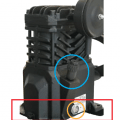Changing the oil on most homeowner DIY compressors is far easier than changing the oil on your car or truck. Unfortunately, compressor maintenance tends to get overlooked since it’s easy to ignore your air compressor until it breaks. Changing the oil will help prevent that.
Oil-lubricated air compressors are a very popular choice due to their longer lifespan when compared to their oil-free counterparts. This means they require regular oil changes-just as a car engine would.
Changing your air compressor’s oil is important not only to its product life but also to the efficiency of the machine. This article will provide a guide on how, when and the amount of oil you need for changing air compressor oil.
Table of Contents
- Equipment Needed to Change Air Compressor Oil
- How Often Should I Change Air Compressor Oil?
- How to Change Air Compressor Oil Guide
- Air Compressor Oil Viscosity
- FAQs (Frequently Asked Questions)
Equipment Needed to Change Air Compressor Oil
First of all, let’s ensure you have all the equipment you need to change your air compressor oil. This includes:
- Drain pan (or something similar like a receptacle for catching the old oil)
- Funnel
- Clean rags
- Wrench or socket to remove the drain plug
- New compressor oil with the correct viscosity
While it may sound like a no-brainer, you should first make sure that your compressor even uses oil. A lot of smaller portable compressors are defined as “oilless” and don’t use nor need oil refilling.
Now that you’ve determined that your compressor definitely requires oil, I’d recommend locating your owner’s manual and seeking the specific oil-change instructions provided by the manufacturer. Note the proper type of compressor oil to use and ensure you have enough on hand. Most compressors require less than a quart of compressor oil.
If you cannot locate your owner’s manual, it may be worth conducting a search online to find it using your compressor’s make and model. Otherwise, the proceeding information can be used as a guide.
How Often Should I Change Air Compressor Oil?
How often you should change compressor oil typically depends on the type of compressor you have and your operating conditions. Small homeowner/DIY reciprocating compressors require oil changes more often compared to larger industrial compressors that may be able to go thousands of hours because they have a greater oil reservoir.
Just how often to change your air compressor oil is tough to nail down. There’s no good rule of thumb given the variability of operating conditions across each air compressor. Your owner’s manual will be able to provide specific recommendations so I would advise checking there.
An example would be a manufacturer of the compressor recommending that you change the oil every 100 operational hours, which is typical of homeowner compressors.
Regardless of how often you use your compressor and the operating conditions, my recommendation is that check the oil level every time you use it. This is the best way to keep on top of it and determine oil condition along with when you need to refill it.
How to Change Air Compressor Oil Guide
Here is a simplified step-by-step guide on how to change air compressor oil, with a more detailed description provided in the paragraphs below!
How to change air compressor oil step-by-step: Time estimation around 5-10 minutes
- Locate components
Locate the oil-fill cap, sight glass, and drain plug on your air compressor.
- Run the compressor
Run the compressor for a few minutes to allow the oil to warm up.
- Empty oil
Empty oil into a catch drain, reservoir, or something similar.
- Replace the drain plug
Wipe the drain plug with a rag and screw it back into the oil sump.
- Pour in new oil
Remove the fill cap and pour the replacement oil into the sump to the correct level.
- Replace the fill cap
Screw in the drain plug and you’re done!
1. The first step is to locate the oil-fill cap, sight glass, and drain plug on your air compressor. On some compressors, the sight glass can double as the drain plug. These components are more often than not accessible, but if not, remove any shrouds or other components that may be blocking your access.
Tip: When checking the oil level in your sight glass, note the level. It should roughly be about halfway up the glass, which will be noted by the red dot on the glass.
2. Before you begin to drain the oil from the compressor, it is advised to run the compressor for a couple of minutes to allow the oil to warm up. With the oil warm, it will flow far more easily and help you to remove contaminants that might have settled in the oil sump.
3. Now, place a catch can or drain pan under the drain plug and begin to drain the old oil. On some models of air compressors, the drain plug may be positioned in a very awkward place that doesn’t allow positioning a drain pan directly underneath. In this case, you should use a small funnel, piece of metal, or any other device to help direct the old oil into the pan.
Tip: You should check the old oil you’ve just removed for contaminants, such as metal particles. Also, look out for the oil being a milky color, as this will indicate moisture inside. These tips will give you a clue that there are potential problems that may require your attention and fixing.
4. While the drain plug is removed, check the condition of the drain plug O-ring, and replace it if it’s deformed in any way. Then, wipe the drain plug and drain-plug opening with a clean rag before placing the plug back in and torquing it to the specs in your owner’s manual.
Tip: If you don’t know the right specs, snug it down and ensure you avoid over-tightening.
5. Next, remove the fill cap and add the correct amount of new compressor oil, using the sight glass to help you determine this correct fill level. Most home/DIY compressors take only a pint or two of oil, so you won’t need to add much if you have a small compressor.
6. Finally, replace the fill cap and you’re done. That’s all there is to changing air compressor oil.
Air Compressor Oil Viscosity
I mentioned earlier the importance of the viscosity of the replacement oil, and I would like to reiterate this. Just like with your car or truck, your compressor requires a specific viscosity of oil, generally ISO 68 or ISO 100. And you will find the viscosity printed on the front of the oil label.
You should check your owner’s manual to find out what viscosity oil your air compressor requires. You may be lucky and even have it stamped somewhere on the compressor itself.
It’s crucial to be using the correct viscosity to ensure the protection of the compressor. Using a viscosity that’s too thin can reduce the compressor’s protection to wear, while a compressor oil that’s too thick can reduce energy efficiency and increase the operating temperature, which will ultimately lead to oxidation and shorten the oil’s life.
FAQs (Frequently Asked Questions)
You should change the oil in your compressor as specified in your owner’s manual by your manufacturer. If you cannot locate yours, search for it online or contact the compressor manufacturer directly for guidance. Otherwise, check the oil level using the sight glass every time you use the compressor to stay on top of the situation.
In simple terms, locate the drain plug on the air compressor and drain the existing oil into a reservoir of some sort. Screw the drain plug back in before opening the fill port and pouring the new oil into the air compressor to the correct level, which can be gauged by the sight glass. For more detailed information, read this guide.
Yes, all air compressor manufacturers will specify an exact amount of time, usually working/operating hours, that your air compressor oil should be drained and refilled with new oil.
The most important consideration when selecting the right oil for your air compressor is the viscosity of the oil. Typically, your air compressor manufacturer will recommend an oil to use in the owner’s manual, but if you cannot purchase this oil then it is imperative that your purchase oil with the same viscosity as the recommended oil so that you and the compressor do not face any issues.
Please leave a comment below if you have any questions regarding this topic!


